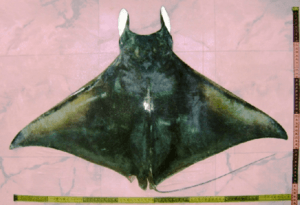Bentfin devil ray facts for kids
Quick facts for kids Bentfin devil ray |
|
|---|---|
 |
|
| Conservation status | |
| Scientific classification | |
| Kingdom: | |
| Phylum: | |
| Class: | |
| Order: | |
| Family: |
Mobulidae
|
| Genus: |
Mobula
|
| Species: |
M. thurstoni
|
| Binomial name | |
| Mobula thurstoni (Lloyd, 1908)
|
|
The bentfin devil ray (Mobula thurstoni) is a fascinating type of ray. People also call it the lesser devil ray or smoothtail devil ray. These amazing creatures belong to the Mobulidae family. You can find them all over the world in warm oceans. They live in tropical, subtropical, and even some warm temperate waters. They swim both far out in the ocean and closer to the coasts.
Contents
About Bentfin Devil Rays
What Do They Look Like?
The bentfin devil ray is quite large. Its body, called a disc, can be almost 2 meters (about 6 feet) wide! It can also weigh around 54 kilograms (about 119 pounds). The front of its disc is mostly straight near its snout. But it curves smoothly towards its wide, triangular fins. The back edge of the disc curves inward, then straightens out near the tail.
On each side of its snout, it has special flaps called cephalic flaps. Its mouth is located underneath its head. The ray's tail is usually about half to the full width of its body. Unlike some other rays, the bentfin devil ray does not have a spine on its tail. Its top side is dark grey or olive-grey, while its underside is white. The tips of its pectoral fins are black at the back and white at the front. The tip of its dorsal fin is also white.
Where Do They Live?
Bentfin devil rays are found all around the world. They live in tropical and subtropical parts of the Atlantic, Indian, and Pacific Oceans. This means they like warm ocean waters. When they are near the coast, they usually swim in the open water. They rarely go deeper than about 100 meters (330 feet).
What Do They Eat?
Like many other rays, the bentfin devil ray eats tiny ocean creatures called plankton. As it swims, water flows into its mouth. Special filters, called gill rakers, then strain out the plankton. The water leaves through its gills. In places like the Gulf of California, they mostly eat a type of krill called Nyctiphanes simplex. They also enjoy eating opossum shrimps during certain times of the year.
Why Are Bentfin Devil Rays Endangered?
Bentfin devil rays are large fish that grow up slowly. They also have very few babies, usually just one pup at a time. Even though they live in many different places, they are in danger. Fishing boats sometimes catch them on purpose. They are also often caught by accident in fishing nets. This is called bycatch.
Reports show that these rays are caught in places like Indonesia, the Philippines, Mexico, and Brazil. Their meat is eaten, and their gill rakers are also valuable. Because their numbers are unknown and they are reported as uncommon, the International Union for the Conservation of Nature has listed them as "endangered". This means they are at high risk of disappearing forever if we don't protect them.
Images for kids



